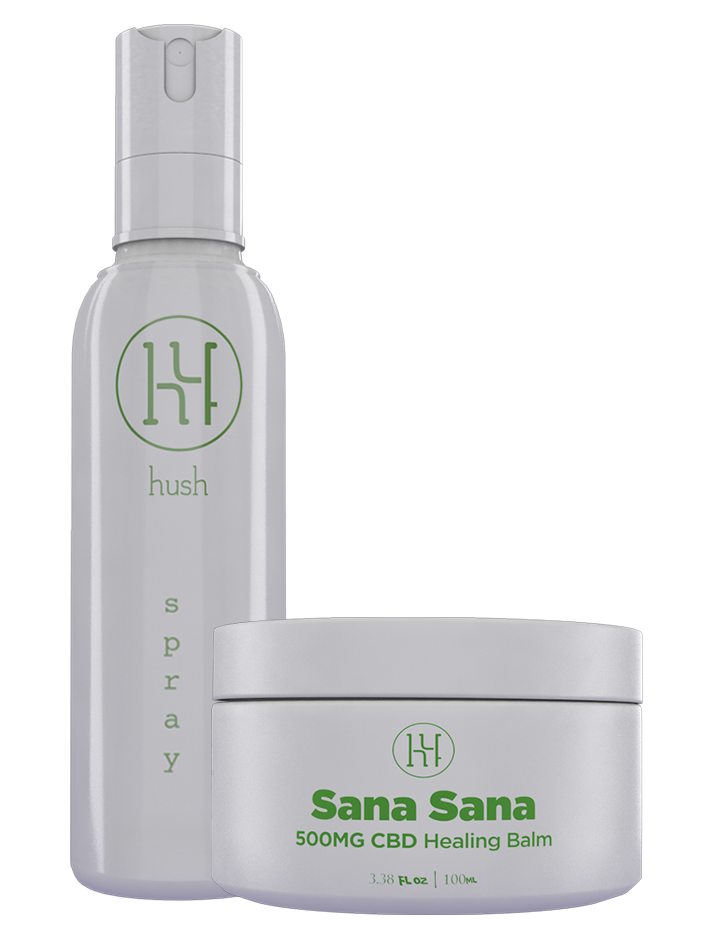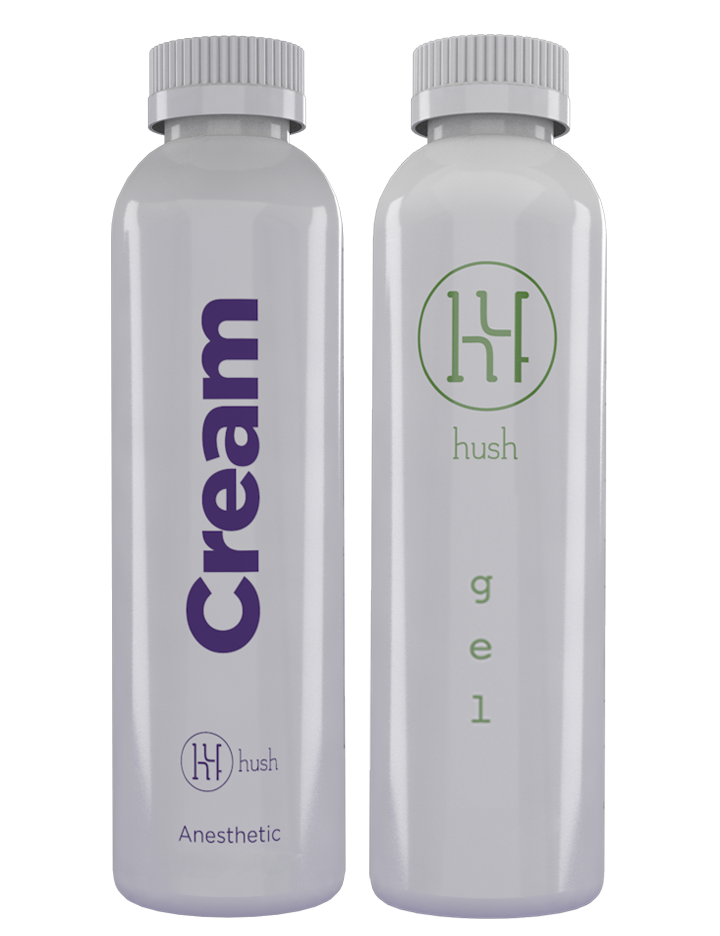
$10.99
Every tattoo requires proper healing. The process you choose affects the tattoo’s long-term color saturation and overall appearance. Selecting a safe healing method that works for you is crucial to the appearance of your ink.
Controversy exists over which healing method, wet or dry, is the “right” one to heal your tattoos, with varying methods questioned. So, let’s talk about dry healing. What does it entail? Should you try it? Does it work?
HUSH is here to give you all the deets on dry healing tattoos so you can make an informed decision for yourself.
What Is Dry Healing?
Dry healing is an uncomplicated and more natural approach to tattoo healing. Dry healing a tattoo means that you do not use lotions, ointments, or other topical moisturizing creams during the healing process.
You follow the traditional healing processes but allow the tattoo to heal in the open air. The tattoo artist places a removable bandage over your tattoo before leaving the shop. When you remove this bandage, the typical cleaning procedure involving anti-bacterial soap remains in place to prevent infection.
Besides that, as long as you are mindful of sun protection and water exposure, there isn’t anything else to do during the dry healing process.
Why Choose the Dry Healing Approach?
The dry healing approach may work well for some people, but may not work as well for others. That said, there can be benefits to this healing method. Some people have sensitive skin that reacts to many things such as soaps, alcohol, mineral oil, fragrances, lotion, and even sun exposure.
Dry healing prevents your already sensitive skin from becoming even more irritated on top of being freshly inked. Additionally, remembering to apply aftercare products is a daily habit that is non-negotiable if you choose not to dry heal.
Consider whether or not you can maintain the daily practice of using a moisturizing agent. Some tattoo enthusiasts swear by the dry heal approach. They consider the skin a “force field” that protects the deeply embedded tattoo ink.
Qué padre, no? Well, according to this ideology, should anything, including moisturizers, penetrate the top layer of skin, it may lessen the color saturation and vibrancy of their latest work of art.
Dry Healing vs Wrap Healing
When it comes to tattoo aftercare, there are two things you can do: dry healing and wrap healing. Dry healing involves letting the tattooed area breathe without any coverings, which can potentially work in a very clean environment if you avoid tight clothing that might irritate the tattoo, exposure to water, and exposure to the sun.
This method is all about hydration, using moisturizers sparingly to avoid dryness, itchiness, and irritation like rashes. Unfortunately, it rarely works out that way.
The world is covered in germs and free radicals. Your skin won't get the hydration it needs to heal, and a lack of protective barrier will allow your tattoo to become a dry, cracked breeding ground for germs that can potentially cause infection—no, thank you.
Luckily, there are other tattoo care instructions you can follow. Wrap healing, on the other hand, often uses a protective film like Saniderm to shield the fresh tattoo from contaminants and friction. Chances are high your tattoo artist told you to wrap heal your tattoo, and following the aftercare instructions is crucial.
Your artist should have everything you need to know about caring for your specific tattoo, and they gave you an aftercare routine to promote proper healing and avoid complications.
What Are the Pros of Dry Healing a Tattoo?
You should make a confident and informed decision on which healing method you prefer to take. There are several things to consider:
- No Additional Cost - Dry healing tattoos requires no costs for moisturizers or other skincare solutions.
- No Skin Reactions - Irritation and allergic reactions from creams and lotions do not occur when dry healing is the chosen tattoo healing method.
- Saves Time & Effort - Dry healing your new ink saves the time and effort of applying a moisturizer several times per day.
What Are the Cons of Dry Healing a Tattoo?
Regardless of which tattoo healing process you choose, the risks remain the same. A needle injects tiny bits of ink into your skin during the tattoo process, and this causes an open wound on the skin, prone to infection and irritation.
Here are the cons of dry tattoo healing:
- Dry Skin, Cracking Skin - The skin becomes dry and tight during the healing process and sometimes causes skin cracking. Some claim this affects the way the tattoo looks after it heals. Using moisturizers can help prevent dry skin and itching, alleviating this uncomfortable stage of the healing process.
- Itching, Flaking, Scabbing, and Peeling - Some people can’t resist picking or scratching at the dry, flaking skin on and around the tattoo. But doing so affects the skin's dermis (inner layer), where the ink deposits. When the skin is removed prematurely in this area, it also removes bits of ink saturation, thus affecting the appearance of the tattoo after it heals.
- Scarring - Never scratch your tattoo, regardless of how much it itches. If you scratch a dry tattoo and remove a layer of the scab, you may remove deeper layers of skin without even realizing it, causing eventual deep scarring and a less-than-perfect tattoo.
Dry Healing: Do You Still Have To Clean Your Tattoo?
Cleaning your tattoo is never optional—it’s a must. Consider the area of tattooed skin like you would consider an open wound. If not properly cleaned, it is prone to infection due to bacteria and germs.
Always use a gentle, tattoo-specific soap and warm water to carefully clean that delicate area two to three times per day. Love and care for that new ink—if you put in the love, that ink will give you some love right back in the form of an everlasting masterpiece.
How Should I Dry Heal Tattoos?
Follow these simple yet crucial steps to keep your tattoo healthy and clean during dry healing:
- Avoid all lotions, creams, balms, ointments, and other topical moisturizing agents.
- Keep it clean by using gentle anti-bacterial soap and warm water two to three times per day. Dry it with a clean, lint-free towel or air dry. Seriously. Keep it clean.
- Drink plenty of water to hydrate your skin from the inside out.
- Don’t touch your tattoo. Touching your tattoo introduces bacteria and germs into the open wound, causing possible infection.
- Wear loose, breathable cotton clothing to prevent lint and other debris from clinging to the open wound.
What Are the Steps for All Tattoo After Care?

Tattoo aftercare is crucial no matter which healing method you choose, dry or wet. Here are a few necessary steps every new tattoo owner should keep in mind, regardless of your chosen healing method:
Wash Your Hands
Always wash your hands before touching or cleaning your tattoo. Your hands will spread bacteria and germs to this delicate area if they are not adequately cleaned.
Wash your hands with antibacterial soap and warm water for 20 seconds and dry on a clean, lint-free towel. Keeping your hands so fresh and so clean prevents germs and bacteria from spreading into the new tattoo site and causing possible irritation or infection.
Don’t Replace the Bandage
The tattoo artist places a bandage over the tattoo before you leave the studio. This bandage protects the raw, delicate skin from initial exposure to environmental elements.
Your artist informs you of how long to keep the dressing in place, usually within the first 24 hours. Wash your hands, then remove the bandage carefully. Do not replace the dressing with a new one, as this can prolong the healing process.
Wait Two Weeks
Most tattoo artists tell the client to wait two weeks before getting the tattoo wet. Ask your artist how long they recommend you wait.
Avoid swimming and taking tub baths during the first two weeks after getting your new ink—but no, this is not an excuse to skip your shower. While showering, simply be mindful of your tattoo and do not allow the water to run down on the tattoo.
Keep It Clean
Keeping your tattoo clean is crucial—you don’t want a skin infection. After waiting two weeks, use a gentle, alcohol-free, fragrance-free tattoo cleanser and warm, sterile water to clean the new ink two to three times per day. This cleansing prevents the spread of bacteria and germs, which may cause infection and skin irritation.
Practice Safe Sun
If the sun wreaks havoc on healthy skin, can you imagine what it does to freshly inked skin? The newly tattooed skin is raw and delicate and needs protection from the sun’s rays. Regardless of where your tattoo is located, make sure it is covered loosely with breathable cotton clothing.
If you are directly exposed to the sun, check with your tattoo artist to determine if mineral-based sunscreen 30 SPF or more is acceptable to use over that delicate new ink. After the tattoo heals, always protect it and the rest of your skin with SPF 30 or more.
Apply 15 minutes before sun exposure and reapply at least every two hours. Sunscreen prevents your tattoo from fading, prevents sunburn, and may prevent some skin conditions such as melanoma and skin cancers.
Don’t Pick the Scabs
Whatever you do, don’t pick the scabs. We realize it is tempting, but avoid picking, scratching, or pulling the scabs at all costs.
Doing so will prolong the healing time, cause infection, and lead to unsightly scarring. When the scabs peel away prematurely, the tattoo may heal to look different than you expected, or worse—it may cause scarring. The horror!
The Bottom Line
Tattoo aftercare is crucial, regardless of the method you choose. Play it safe—improper care leads to possible scabbing and scarring, resulting in a healed tattoo that just does not look the way you intended it to look.
The alternative to dry healing is wet healing, which involves gentle moisturizers applied to the skin, and we think you know which one we’re partial to. HUSH’s tattoo numbing and tattoo aftercare products provide safe, gentle solutions for both the tattoo sesh and the healing process that comes after.
Keep your tattoo clean with HUSH CBD foam soap, an alcohol-free and fragrance-free formula explicitly designed for the delicate skin on and around the new tattoo. Then, we prefer you follow by moisturizing with HUSH CBD Healing Balm to keep your skin radically rejuvenated and nourished. If you reaaallly want to dry heal, go for it—just promise us you’ll keep an eye on that baby, and keep our healing balm handy in case your skin sends out an SOS for some moisture.




